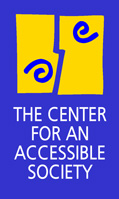
DISABILITY
ISSUES
INFORMATION
FOR
JOURNALISTS
ABOUT
THE CENTER
Section 508 at the one-year mark
Note to readers: links to news articles may not work after a few weeks, as news media remove current stories to their archives. The link may take you to the archives section, where, for a fee, you can view the article.
June 19, 2002 -- One year ago this month, regulations for Section 508 of the Rehabilitation Act took effect. The rules say that technology developed, procured or maintained by federal agencies must be accessible to people with disabilities.
Next Monday, June 24, the Information Technology Technical Assistance & Training Center will host a free, two-hour Section 508 Anniversary Web Cast. Representatives from industry, federal government, and the disability community will exchange information about best practices and lessons learned, and identify barriers and remaining challenges to successful implementation. More information is available at http://www.ittatc.org/training/webcast5.cfm
Federal agencies leading the pack in compliance with Section 508 are the Internal Revenue Service, the Social Security Administration, the Postal Service and the Department of Education.
Section 508 sets accessibility standards that any technology product must be measured against before a federal agency can consider purchasing it. As a result, any technology company that wants to do business with the U.S. government -- one of the world's largest markets for electronic and information technology -- must make accessibility a priority.
Those federal agencies getting top marks for technology access have been focusing on it since the 1980s, said Douglas Wakefield of the U.S. Access Board. The Department of Education, for example, has a specific unit that reviews all software procurements within the agency to ensure compliance with 508.. "Most Federal agencies don't have the infrastructure set up to handle 508," said Wakefiled, who added that the key to 508 compliance was having an infrastructure to ensure procurements would include access.
Section 508 does not require private companies to make their products accessible, but it provides a powerful incentive for companies that want a part of the $40 billion dollar-a-year federal information technology market.
A General Accounting Office report issued prior to Section 508 rules were published last year "found that 80 percent of federal agency websites in fact didn't need any work," according to Wakefield. That's because, unlike commercial websites set up to sell products which web designers believed need high visual content, says Wakefield, government sites are designed to provide information quickly -- and this generally translates into a website that has clear navigation and does not rely on graphics to provided information.
"It does not necessarily take more time or cost more money to design accessible Web sites. The Web was designed to be flexible. Why not work within the medium and build Web sites that are accessible to the largest possible audience?" writes web designer Sara Horton in the June 10 New York Times Technology section (online at http://www.nytimes.com/2002/06/10/technology/10NECO.html)
Other good articles on what's happening at this one-year anniversary of Section 508 include ("Section 508 'not as hard as people thought," by Gail Repsher Emery from Washington Technology, online at http://www.washingtontechnology.com/cgi-bin/udt/im.display.printable?client.id=wtdaily-test&story.id=18304) and "Access Granted" by Brian Friel in the June 1 Government Executive magazine (online at http://www.govexec.com/features/0602/0602s4.htm).